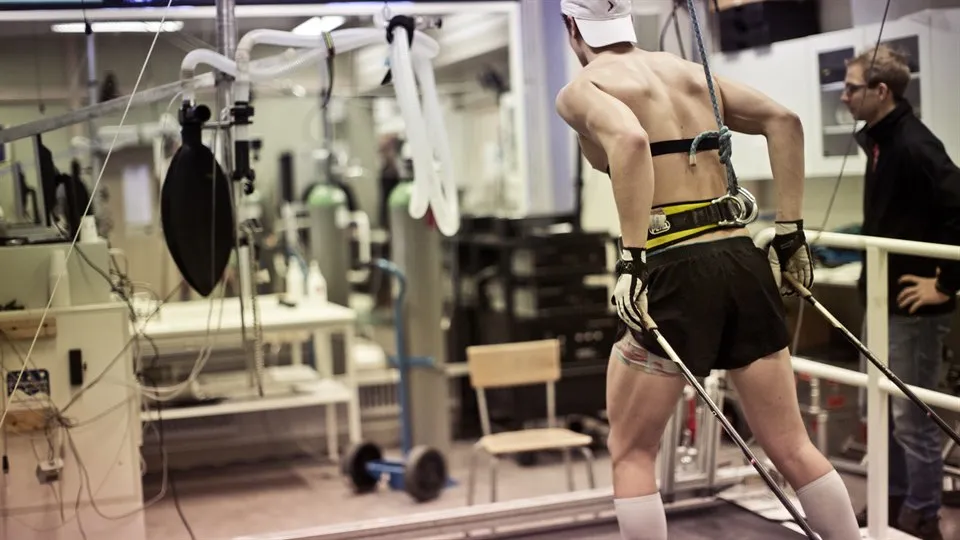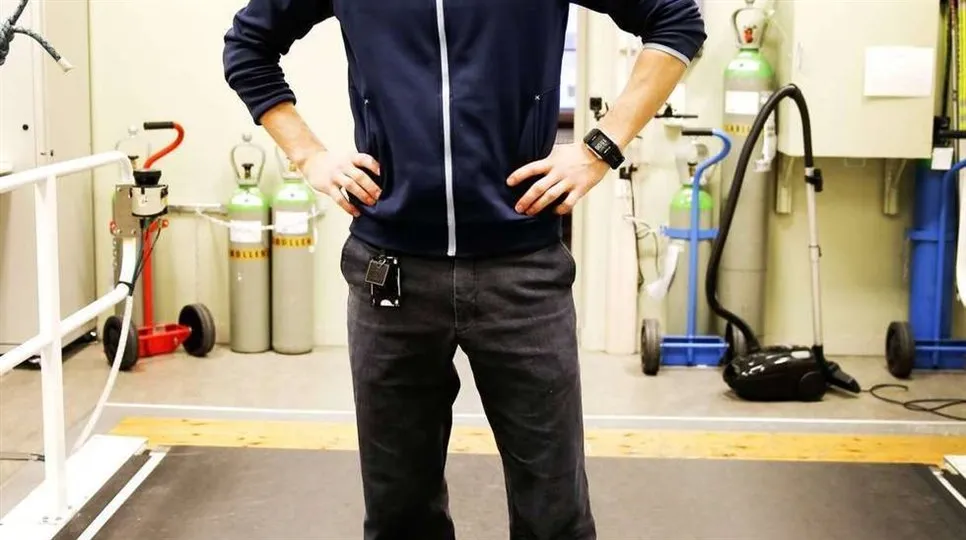Laboratory testing – more than just numbers on a piece of paper
Whether reading scientific articles on sports physiology or newspaper articles about sports, one is faced with information in terms of numbers and results. In the case of goals scored in a hockey match, it is obvious what the numbers mean, but when it comes to test results it is important to know more about the methods behind the results, how the numbers are produced, how precise the results are and, not least, how to interpret them.
The aim of testing
As a test leader at the Swedish Winter Sports Research Centre (Nationellt vintersportcentrum, NVC), we are often asked by athletes and coaches about the purpose of coming to the lab to carry out tests. Is it not enough to perform field tests and outdoor training competitions to see how you have progressed and developed as a skier? All our tests are principally designed to evaluate how an individual's physiological, technical and mental qualities combine to achieve performance and ultimately results. For sure, by regularly testing yourself over a certain distance you can quickly evaluate whether you have developed and achieved better results since your last test. However, this is where the lab tests come into play; they can answer the questions of why and how. What of all that has been done since the last test actually makes you perform better?
Standardisation and quality control
One of the main advantages of carrying out tests in a lab is the standardisation of the conditions under which the tests take place. Unlike in an outdoor environment, in a lab everything from air temperature, rolling resistance of roller skis, running surfaces, slope gradients, speeds, etc. can be standardised in order to exclude these external factors from the test results. In addition to these factors, quality control is ongoing continuously on all equipment used in our labs to ensure that any changes in test results depend on the training of the athlete and not on mechanical errors.
We carry out validation work with our lab equipment twice a year, prior to the major spring and autumn testing periods, where the equipment is compared to a standard method. This is of utmost importance to be able to deliver accurate test results. It is also important that the athletes themselves do their best during the tests so that the results reflect their actual performance level. In addition to equipment validation tests, we also provide standardised information to the athletes before their test. By reading, understanding and following our instructions we give our athletes the best possibility for obtaining reliable test results, allowing us to be more effective in evaluating the training of the athlete.
Testing our cross-country skiers
We have recorded test data from the national team in cross-country skiing at the NVC since 2003. They have tested their fitness levels in the spring before the summer training period and again in the autumn closer to the competitive season. The test package has remained much the same, with some changes over the years to better follow the latest research findings and glean even more information from the tests. Each test has its own purpose and below is a brief summary of how the tests are conducted and interpreted.
Body composition measurements – IDXA
Developed by NASA to measure the bone density of homecoming astronauts, iDXA today is a well-used method of measuring both body composition and bone density. With an examination time of less than 15 minutes and a radiation dose corresponding to a normal flight, iDXA is also a very useful tool as part of a physiological testing program. The machine measures variables such as absolute bone mass, fat mass and fat-free mass but also relative distributions of tissue, such as fat percentage. With careful positioning, one can also see the distribution of different types of tissue in the body and, for example, evaluate right- and left-side differences in muscle mass.
Measuring body composition may lead the athlete to focus on having a low body fat percentage. Here it is important to emphasise to athletes that attaining a low body fat percentage does not directly lead to improved performance, but is rather one of many pieces of the puzzle and must be used in consultation with an expert.
Since very low levels of body fat can negatively affect skeletal bone density, it is important to regularly monitor body composition in athletes over time. Bone density measurements with iDXA can also allow for treatment before osteoporosis or fractures occur. Overall, we assess how well balanced the athlete's body is, both in terms of long-term energy balance and in the distribution of muscle mass, all to improve health and reduce the risk of injuries due to imbalances.
Lactate threshold / submaximal test
In a lactate threshold test the athlete completes a number of submaximal loads (e.g., 60, 70, 80, 85, 90 and 95% of maximal load) for 3-5 minutes each, for the body to meet and stabilise its energy needs and achieve a steady state during each level. Heart rate (HR), oxygen uptake (VO2), blood lactate and a rating of perceived exertion (RPE, using the Borg scale) measurements are made during each level to monitor the physiological and subjective responses at each load. After the test, all values are presented in a report containing a lactate curve (the blood lactate concentration versus exercise load on the X and Y axes, respectively), which shows how the body's blood lactate levels change with increased external load.
On a repeated lactate threshold test, the athlete wants to see a lowered and right-shifted lactate curve compared to previous tests. This is a sign that the individual has improved their ability to perform with a lower level of lactate accumulation, and has therefore become better at working aerobically (i.e., without producing lactate) and/or more effective in removing the lactate that has been produced anaerobically. From VO2 and carbon dioxide production (VCO2), one can also see the distribution of fat and carbohydrate metabolism, which is an important endurance factor, since well-trained individuals can use fat more effectively and at higher exercise intensities than lesser-trained individuals.
Fat metabolism can be compared to a diesel engine, whereas carbohydrate metabolism is much like a gasoline engine, which generally accelerates faster but also empties the gas tank sooner. The ability to increase fat metabolism is therefore beneficial during long-lasting endurance exercise where the body's carbohydrate deposits are at risk of running out. Work economy can also be calculated by measuring VO2 and VCO2 throughout a submaximal test. For further reading around the various determinants of endurance performance we recommend referring to Jones & Carter (2000) and Joyner & Coyle (2008).
Time trial / VO2max test
A common test in both research and elite testing is a VO2max test, which tests an individual's maximum capacity to produce energy using oxygen. Over the years it has been common practice to use a so-called "ramp test", where gradient and/or speed (or power in cycling) are increased periodically until the athlete simply chooses to quit the test. This type of test is relevant if you are only interested in VO2max, but is not reflective of real-world competitive scenarios.
Research has shown that a so-called "time-trial" test can yield equally high VO2max results as a ramp test in trained cross-country skiers, but is also able to provide information on other physiological and performance-related factors (McGawley & Holmberg, 2014). Two years ago the NVC switched to time-trial tests with our athletes from the cross-country and biathlon teams. During this test, gradient remains constant but, as in a real-world race, the athlete covers a fixed distance as fast as possible (between 600-1000 m, depending on athlete sex and skiing technique used). The speed of the treadmill is controlled by the athlete by a laser speed control system, meaning that the athlete performs (or "paces") the test the way he or she wishes.
For best results, an offensive start seems to be advantageous as it promotes a faster physiological adaption in terms of aerobic and anaerobic responses (Andersson et al., 2016). From this test we can report performance time, pacing strategies, VO2max and anaerobic capacity.
30-s double-poling ergometer test
The last test the cross-country skiers do in their testing program at the NVC is a 30-second "all-out" double-poling test on a Concept ergometer. As the submax and the VO2max tests both use diagonal skiing, this is the only test of double-poling capacity and its short testing time with a maximal start gives a good measure of the athletes' explosiveness and short-term, sprint performance.
Final words
Conducting tests is only worthwhile if those being tested, the athletes and their coaches, take the time and effort to analyse and use the results. This requires a certain level of knowledge and understanding. We hope that through our partnership with the Swedish ski association we can help to promote and develop knowledge and understanding within cross-country skiing in Sweden!
References
Andersson, E., Holmberg, H. C., Ørtenblad, N., & Björklund, G. (2016). Metabolic responses and pacing strategies during successive sprint skiing time trials. Medicine & Science in Sports & Exercise, 48(12), 2544-2554.
Jones, A. M., & Carter, H. (2000). The effect of endurance training on parameters of aerobic fitness. Sports Medicine, 29(6), 373-386.
Joyner, M. J., & Coyle, E. F. (2008). Endurance exercise performance: the physiology of champions. Journal of Physiology, 586(1), 35-44.
McGawley, K., & Holmberg, H. C. (2014). Aerobic and anaerobic contributions to energy production among junior male and female cross-country skiers during diagonal skiing. International Journal of Sports Physiology & Performance, 9(1), 32-40.


